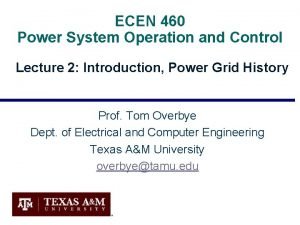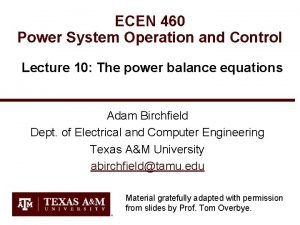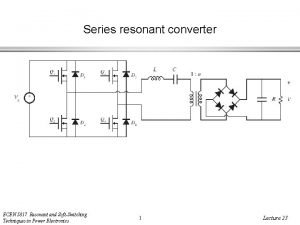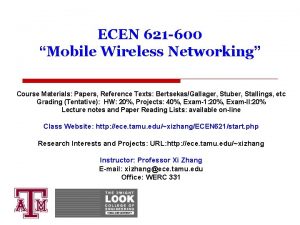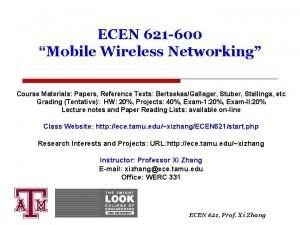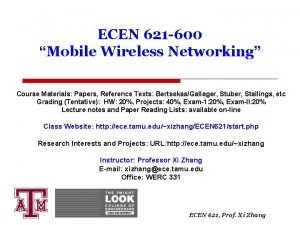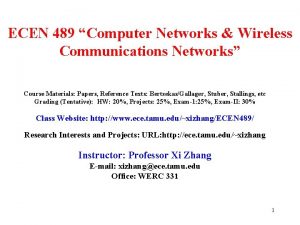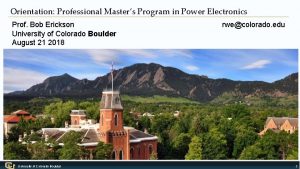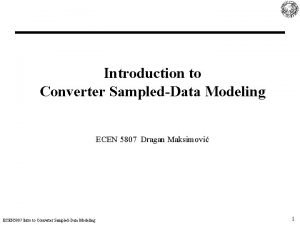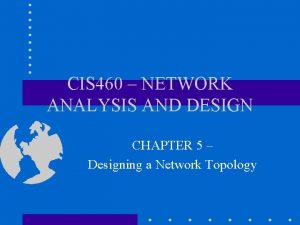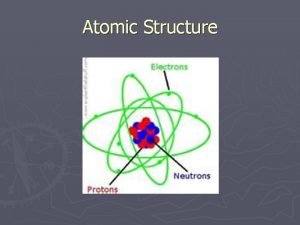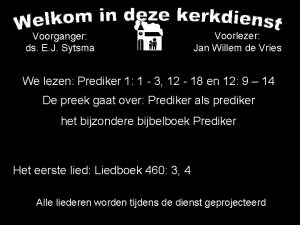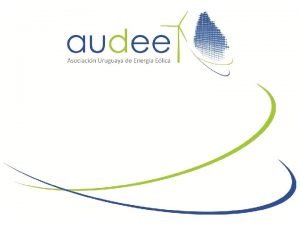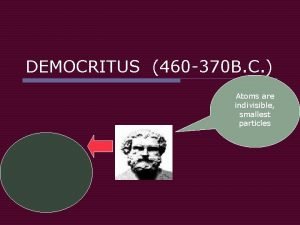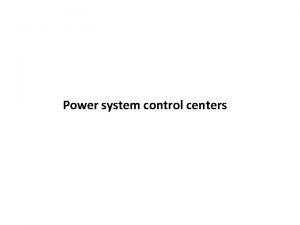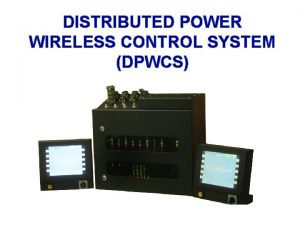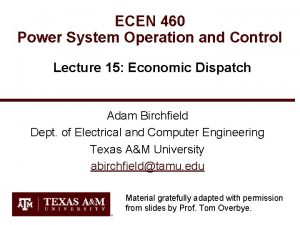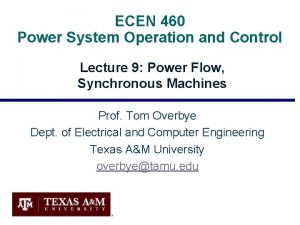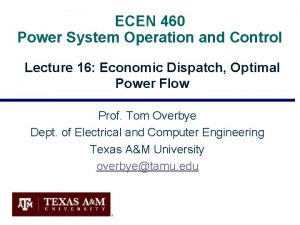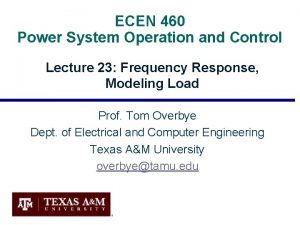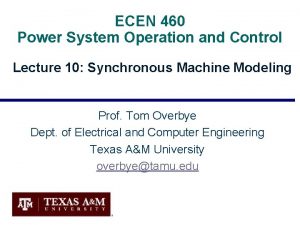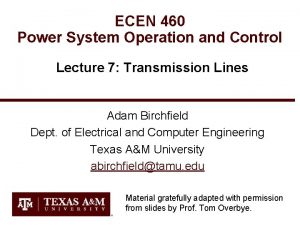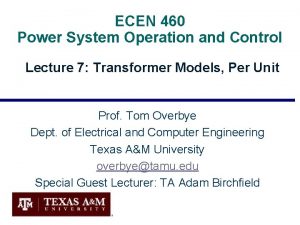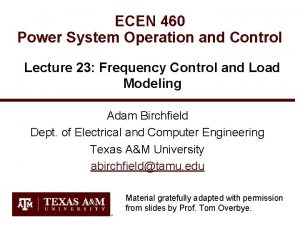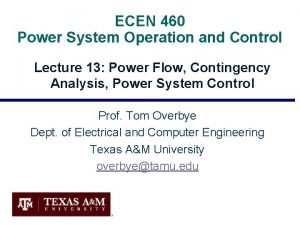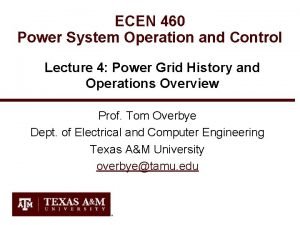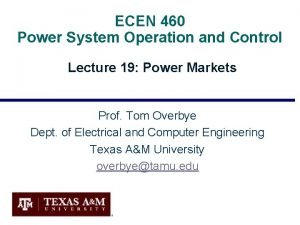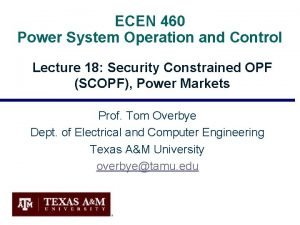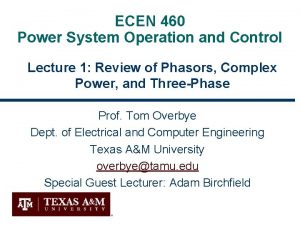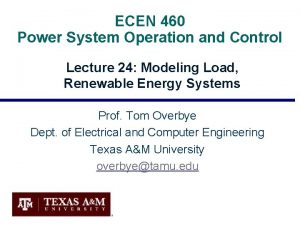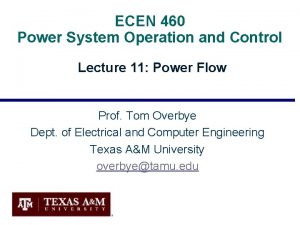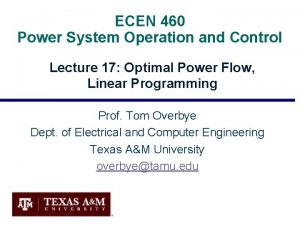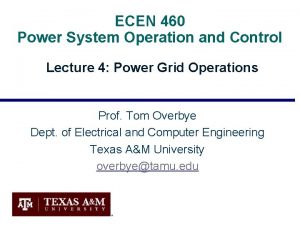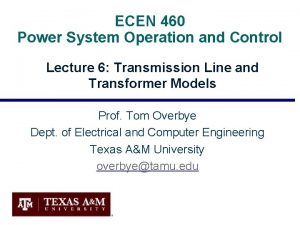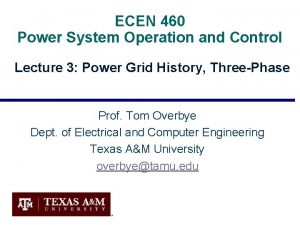ECEN 460 Power System Operation and Control Lecture






































- Slides: 38

ECEN 460 Power System Operation and Control Lecture 2: Introduction, Power Grid History Prof. Tom Overbye Dept. of Electrical and Computer Engineering Texas A&M University overbye@tamu. edu

Syllabus Slides will be posted before each lecture on the website 1

Course Topics • • Introduction and review of phasors & three phase Transmission line and transformer modeling Models for generators, and loads Power flow analysis and control Economic system operation/restructuring Power system stability Distribution systems Emerging topics 2

Announcements • Please read Chapters 1, 2 • HW 1 is 2. 9, 22, 28, 43, 48; due Thursday 9/14 • Regular problems (not multiple choice) • Labs will start next week (Sept 11) 3

About Me • Professional – – – Received BSEE, MSEE, and Ph. D. all from University of Wisconsin at Madison (83, 88, 91) Worked for eight years as engineer for an electric utility (Madison Gas & Electric) Was at UIUC from 1991 to 2016, doing teaching and doing research in the area of electric power systems Joined TAMU in January 2017 Developed commercial power system analysis package, known now as Power. World Simulator. This package has been sold to about 600 different corporate entities worldwide DOE investigator for 8/14/2003 blackout 4

Research Group, Fall 2017 5

About Prof. Tom Overbye • Nonprofessional – – Married to Jo Have three children • • • – – Tim age 22 Hannah age 20 Amanda age 18 We’ve homeschooled our kids all the way through, with Tim now in his last year at UIUC in ME and Hannah in her third year in psychology, and Amanda is just now starting at Belmont Attend Grace Bible Church in College Station 6

About TA Adam Birchfield From Easley, South Carolina, USA Education: • Ph. D. (in progress), Texas A&M University • M. S. , University of Illinois at Urbana-Champaign • B. of E. E. , Auburn University Research Interests: Power system simulation and analysis, including transient stability, system planning, and visualization. Adviser: Prof. Tom Overbye A more familiar setting Family: dad, mother, brother, two sisters Thanksgiving 2016 7

About TA Tian Lan From Wuhan, Hubei, China Office: Wisenbaker 320 H Education: • Ph. D. (in progress), Texas A&M University (2013 -now) • B. E. , Huazhong University of Science and Technology (2009 -2013) Teaching experience: • TA for ECEN 460 (2014 fall, 2015 fall, 2016 fall) • TA for ECEN 459 (2014 spring) Research Interests: Power system stability, renewable integration, smart grid, optimization. Adviser: Prof. Garng M. Huang 8

About Grader Yuqi Zhou • MSEE student at Texas A&M • Research interests include power system state estimation and cyber-security in smart grid • Likes playing basketball and tennis • Office: 053 G WERC • Email address: zhouyuqi@tamu. edu 9

ECEN 460 Motivation: A Vision for an Long-Term Sustainable Electric Future • In 2000 the US National Academy of Engineering (NAE) named Electrification (the vast networks of electricity that power the developed world) as the top engineering technology of the 20 th century – – Beating automobiles (2), airplanes (3), water (4), electronics (5) Electricity has changed the world! • For the 21 th century the winner could be “Development of a sustainable and resilient electric infrastructure for the entire world” 10

Power System Examples • Electric utility: can range from quite small, such as an island, to one covering half the continent – there are four major interconnected ac power systems in North American, each operating at 60 Hz ac; 50 Hz is used in some other countries. • Microgrids can power smaller areas (like a campus) and can be optionally connected to the main grid • Airplanes and Spaceships: reduction in weight is primary consideration; frequency is 400 Hz. • Ships and submarines • Automobiles: dc 12 V standard; 360 -376 V for electric 11 • Battery operated portable systems

North America Interconnections 12

Electric Interconnections in Texas Source: www. puc. texas. gov/industry/maps/ERCOT. pdf

Electric Systems in Energy Context • Class focuses on electric power systems, but we first need to put the electric system in context of the total energy delivery system • Electricity is used primarily as a means for energy transportation • Use other sources of energy to create it, and it is usually converted into another form of energy when used • About 40% of US energy is transported in electric form • Concerns about need to reduce CO 2 emissions and fossil fuel depletion are becoming main drivers for change in world energy infrastructure 14

Looking at the 2015 Energy Pie: Where the USA Got Its Energy About 40% of our energy is consumed in the form of electricity, a percentage that is gradually increasing. The vast majority on the non-fossil fuel energy is electric! About 81% Fossil Fuels (86% in 1990 and 2000) In 2015 we got about 1. 9% of our energy from wind and 0. 6% from solar (PV and solar thermal), 0. 2% from geothermal Total of 97. 5 Quad; 1 Quad = 293 billion k. Wh (actual), 1 Quad = 98 billion k. Wh (used, taking into account efficiency) Source: EIA Monthly Energy Review, July 2016 15

US Historical Energy Usage Source: EIA Monthly Energy Review, July 2017 16

Renewable Energy Consumption Source: EIA Monthly Energy Review, July 2017 17

Growth in US Wind Power Capacity Source: AWEA Wind Power Outlook 2 Qtr, 2017 18

Wind Capacity Installations by State Texas is number one! Source: AWEA Wind Power Outlook 2 Qtr, 2017 19

The World Source: EIA, International Energy Outlook 2016 20

Energy Economics • Electric generating technologies involve a tradeoff between fixed costs (costs to build them) and operating costs • • • Nuclear and solar high fixed costs, but low operating costs (though cost of solar has decreased substantially recently) Natural gas/oil have low fixed costs but can have higher operating costs (dependent upon fuel prices) Coal, wind, hydro are in between • Also the units capacity factor is important to determining ultimate cost of electricity 21

Ball park Energy Costs Energy costs depend upon the capacity factor for the generator. The capacity factor is the ratio of the electricity actually produced, divided by its maximum potential output. It is usually expressed on an annual basis. Source: Steve Chu and Arun Majumdar, “Opportunities and challenges for a sustainable energy future, ” Nature, August 2012, Figure 6 22

Natural Gas Prices 1997 to 2017 Marginal cost for natural gas fired electricity price in $/MWh is about 7 -10 times gas price Source: http: //www. eia. gov/dnav/ng/hist/rngwhhd. W. htm 23

Coal Prices have Fallen Substantially from Five Years Ago BTU content per pound varies between about 8000 and 15, 000 Btu/lb, giving costs of around $1 to 2/Mbtu Source: eia. gov/coal 24

Solar PV Prices Image: http: //cleantechnica. com/2015/08/13/us-solar-pv-cost-fell-50 -5 -years-government-report/screen-shot-2015 -08 -12 -at -12 -33 -53 -pm/ 25

Brief History of Electric Power • First real practical uses of electricity began with the telegraph (1860's) and then arc lighting in the 1870’s • Early 1880’s – Edison introduced Pearl Street dc system in Manhattan supplying 59 customers • 1884 – Sprague produces practical dc motor • 1885 – invention of transformer • Mid 1880’s – Westinghouse/Tesla introduce rival ac system • Late 1880’s – Tesla invents ac induction motor • 1893 – Three-phase transmission line at 2. 3 k. V 26

History, cont’d • 1896 – ac lines deliver electricity from hydro generation at Niagara Falls to Buffalo, 20 miles away; also 30 k. V line in Germany • Early 1900’s – Private utilities supply all customers in area (city); recognized as a natural monopoly; states step in to begin regulation • By 1920’s – Large interstate holding companies control most electricity systems 27

History, cont’d • 1935 – Congress passes Public Utility Holding Company Act to establish national regulation, breaking up large interstate utilities (repealed 2005) • This gave rise to electric utilities that only operated in one state • 1935/6 – Rural Electrification Act brought electricity to rural areas • 1930’s – Electric utilities established as vertical monopolies • Frequency standardized in the 1930’s 28

Vertical Monopolies • Within a particular geographic market, the electric utility had an exclusive franchise Generation Transmission Distribution Customer Service In return for this exclusive franchise, the utility had the obligation to serve all existing and future customers at rates determined jointly by utility and regulators It was a “cost plus” business 29

Vertical Monopolies • Within its service territory each utility was the only game in town • Neighboring utilities functioned more as colleagues than competitors • Utilities gradually interconnected their systems so by 1970 transmission lines crisscrossed North America, with voltages up to 765 k. V • Economies of scale keep resulted in decreasing rates, so most every one was happy 30

History, cont’d -- 1970’s • 1970’s brought inflation, increased fossil-fuel prices, calls for conservation and growing environmental concerns • Increasing rates replaced decreasing ones • As a result, U. S. Congress passed Public Utilities Regulator Policies Act (PURPA) in 1978, which mandated utilities must purchase power from independent generators located in their service territory (modified 2005) • PURPA introduced some competition 31

History, cont’d – 1990’s & 2000’s • Major opening of industry to competition occurred as a result of National Energy Policy Act of 1992 • This act mandated that utilities provide “nondiscriminatory” access to the high voltage transmission • Goal was to set up true competition in generation • Result over the last few years has been a dramatic restructuring of electric utility industry (for better or worse!) • Energy Bill 2005 repealed PUHCA; modified PURPA 32

Electricity Prices, 1960 -2010 Source: EIA, Annual Energy Review, 2010, Figure 8. 10 33

Utility Restructuring • Driven by significant regional variations in electric rates • Goal of competition is to reduce rates through the introduction of competition • Eventual goal is to allow consumers to choose their electricity supplier 34

State Variation in Electric Rates 35

The Rise of Natural Gas Generation Source: US EIA, 2016 36

August 14 th, 2003 Blackout Above image from energy. gov, August 14, 2003 Blackout Final Report 37
 Ecen 460
Ecen 460 Ecen 460
Ecen 460 Ecen 5817
Ecen 5817 Ecen 621
Ecen 621 Ecen 621
Ecen 621 Ecen 621
Ecen 621 Ecen 489
Ecen 489 Colorado boulder power electronics
Colorado boulder power electronics Ecen 5807
Ecen 5807 Power system dynamics and stability lecture notes
Power system dynamics and stability lecture notes Power system dynamics and stability lecture notes
Power system dynamics and stability lecture notes Zline 667-36
Zline 667-36 01:640:244 lecture notes - lecture 15: plat, idah, farad
01:640:244 lecture notes - lecture 15: plat, idah, farad Power triangle
Power triangle Atomic universe theory
Atomic universe theory Apnak bang
Apnak bang 460 punkte abitur
460 punkte abitur Porsche rental new orleans
Porsche rental new orleans Cis 460
Cis 460 What scientist discovered the electron
What scientist discovered the electron Gezang 179
Gezang 179 Historical healthcare figures
Historical healthcare figures 342 en yakın onluğa yuvarlama
342 en yakın onluğa yuvarlama Sen 460
Sen 460 Multis complex shd 460
Multis complex shd 460 St 460 ts
St 460 ts When was hippocrates born
When was hippocrates born Hs 460
Hs 460 Democritus 460 bc
Democritus 460 bc Storage and inventory control in operation plan example
Storage and inventory control in operation plan example Power angle curve in power system stability
Power angle curve in power system stability Power semiconductor devices lecture notes
Power semiconductor devices lecture notes Switch mode power supply lecture notes
Switch mode power supply lecture notes Power system control centre
Power system control centre Wireless control system
Wireless control system What is control unit
What is control unit System implementation and operation
System implementation and operation Solar power satellites and microwave power transmission
Solar power satellites and microwave power transmission Potential power
Potential power
